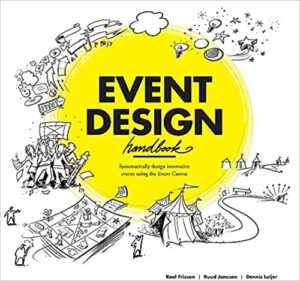“The alternative to good design is always bad design. There is no such thing as no design.” –Adam Judge, The Little Black Book of Design
 Name: Ruud Janssen
Name: Ruud Janssen
Author, Event Design Handbook
What is event design?
Event design is a nascent discipline. Over the past 25 years, through observation, distinguishing patterns and the elemental differences between great, mediocre and poor events, we identified the need to systematically design events using a common language. Because that didn’t exist, my colleague Roel Frissen and I ventured on this quest and created a methodology to systematically design innovative events.
It allows frustrated event owners to get a grip on their own events, create value and measure success through behavior change. Ultimately, teams become changemakers and confident leaders of event design.
There is now a community of 17,459 users of our #EventCanvas around the world. It is producing award-winning events for those trained in it, and is used by organizations in the corporate, NGO, governmental and association space in organizations like Google, Bayer, International Olympic Committee, United Nations, Internet Society, MPI and the Wikimedia Foundation.
Why is it so important now?
The process of articulating behavior change, setting boundaries and prototyping your event from multiple stakeholder perspectives requires team design thinking. Post-pandemic event design will be user-centric, very much like pre-pandemic event design. It will, however, focus on “low touch economy” behaviors.
Event owners have now experienced the status quo of an events world online. We have more building blocks and have carefully observed which event designs have thrived this past year. We know that health is a basic need and can never be tampered with as a variable.
Does event design work for virtual, in-person and hybrid meetings?
Yes, it works for any type of event. What channel you use is a mere prototype or design restriction you set for your team when framing the event design. The ability to think freely in all mediums is what makes event design such a powerful tool to use.
Instructional design and working methods have evolved very quickly. What lags is the digital dexterity of those creating and using the content. Many attempted this pre-Covid, but the adoption has been feeble at best.
While building review materials for the Event Design Certificate program in early 2019, we noticed that online collaboration sometimes formed a hurdle for “live in-person” learners.
Over the last year, we studied the delta, the difference between how meetings created value before and what is happening now and created a collection of case studies and a collaboration space for taking events from in-person to virtual and hybrid.
We have found that the need to meet in person after learning together online has only been amplified. There is a bright future for all types of events in the future.
Is the commitment/return equation more critical now since people have learned they can get the basics without leaving their homes?
Any event that nobody would miss if taken off the table is probably mediocre. And any event that’s memorable, one that people would crave if it was no longer there, one that creates memories, that one has value.
Events should be as long or short as they need to get the job done. The rhythm, frequency and amplitude of change delivered by events will be sliced up differently in the future. It could take the form of an intense sun-chaser event lasting 24 hours, a three-day festival with time zone-sensitive programming or a week-long, wiki-like agenda structured to cater to various stakeholder categories in different parts of the world.
Each interaction means that the duration of events may be halved, if not quartered, for the online versions of many events. But the frequency may be doubled or quadrupled because this is now possible.
Will event owners start charging for online experiences?
It’s a full reboot, not just for the individuals going to those events, but also for event owners to rethink the types of behavioral change they were delivering, for whom they were delivering it, how they were delivering it, why they were delivering it and at what price. Determining what the value of an event is to each stakeholder has become even more important and critical.
Are there better ways than surveys to determine satisfaction?
Events deliver value through behavior change. The difference between the entry and the exit behavior is the design goal. Before the event, everyone has a stake, a set of expectations and a certain entry behavior. After the event, stakeholders walk away with a set of gains and a specific exit behavior. They will inherently have a level of satisfaction related to the expectations before the event. Based on the time they spent at the event (commitment) and what they got back (return), the money they spent going (cost) and money they made (revenue), there is a trade-off they can now assess.




